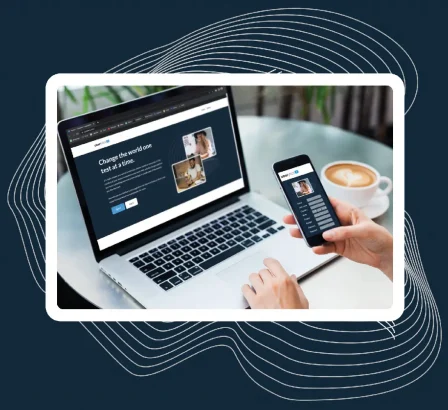
findability
Designers are prone to falling into the trap of cluttering their interfaces. Limitations of space often push them to the wall, and they find themselves trying to fit everything they can into a tiny usable space.
The unique problem that the modern designer faces, be it on the web or in the design of a product, is finding a way to fit all the necessary features while maintaining the highest levels of usability and user experience of the product. This brings up the concept of findability.
What Is Findability?
Findability is a term used to quantify how easily your users find what they are looking for when they are using your e-commerce platform. A cluttered interface would mean that the user will have to spend more time and search harder to find the item they are looking for.
According to the Hick-Hyman Law, the higher the number of options a user is presented with, the slower the detection speed.
Findability deals wit several aspects such as usability, UI design, information architecture, and Search Engine Optimization (SEO).
Types of findability
In the context of e-commerce sites, there are two aspects to findability whose leveraging makes products and information easily discoverable and accessible to users.
External Findability
External findability in the context of e-commerce sites focuses on making the website and its products discoverable and accessible to external users, primarily through search engines and external channels.
It involves strategies and techniques to improve the website’s visibility and ranking in search engine results pages (SERPs) and increase its reach through external channels. Some practices for improving external findability include:
- Search Engine Optimization (SEO): Optimizing the website’s structure, content, and metadata to improve its visibility in search engine results.
- Paid Advertising: Running targeted ads on search engines or social media platforms to increase visibility and attract potential customers.
- Content Marketing: Creating high-quality and relevant content (such as blog posts, videos, or infographics) to attract organic traffic and establish the website as a valuable resource.
The goal of external findability for e-commerce sites is to attract potential customers and drive traffic to the website from external sources.
On-site Findability
On-site findability in the context of e-commerce sites focuses on making products and relevant information easily discoverable and accessible within the website itself.
It involves optimizing the website’s navigation, search functionality, and product categorization to enhance the user experience and help users find what they are looking for. Some practices for improving onsite findability include:
- Clear Navigation: Designing intuitive navigation menus and category structures to help users easily browse and locate products.
- Effective Search Functionality: Implementing a robust search feature that understands user queries, provides relevant results, and offers filters or sorting options.
- Product Organization: Categorizing products into logical groups and using attributes or tags to enable filtering and narrowing down options.
- Related Products and Recommendations: Displaying related products or recommendations based on user behavior or similar items to help users discover relevant products.
The goal of onsite findability is to enable users to quickly and easily find the products they are interested in within the e-commerce site, leading to a seamless shopping experience and increased conversion rates.
The Consequences of Bad Findability on E-commerce

Bad findability on an e-commerce website can have several consequences that can negatively impact the user experience and the overall success of the website.
Decreased Conversion Rates
When users struggle to find the products they are looking for, they are more likely to abandon the website without making a purchase. Difficulties in locating desired products or relevant information can lead to frustration and result in lower conversion rates.
Increased Bounce Rates
Poor findability can contribute to high bounce rates, where users leave the website shortly after arriving. If users can’t quickly find what they need, they may leave the site and seek alternatives, resulting in lost opportunities for engagement and sales.
Loss of Customer Trust and Loyalty
Users expect a seamless and efficient shopping experience. If a website consistently fails to provide easy findability, it can erode trust in the brand and lead to a loss of customer loyalty. Users may turn to competitors that offer better findability and a more user-friendly experience.
Reduced Time on Site
Difficulties in finding products or information can lead to users spending less time on the website. This can hinder exploration, limit engagement with additional offerings, and ultimately reduce opportunities for cross-selling and upselling.
Negative Word-of-Mouth
Unsatisfied users are more likely to share their negative experiences with others, both online and offline. Poor findability can lead to negative reviews, social media complaints, and word-of-mouth that can harm the reputation of the e-commerce website and deter potential customers.
Decreased Search Engine Visibility
Search engines prioritize websites with good findability and user experience. If a website consistently performs poorly in terms of findability, it may receive lower rankings in search engine results, leading to reduced organic traffic and visibility.
Increased Customer Support Inquiries
Difficulties in finding products or relevant information can result in an influx of customer support inquiries and complaints. This can strain customer support resources and increase operational costs.
Overall, bad findability on an e-commerce website can lead to lost sales, decreased customer satisfaction, negative brand perception, and reduced competitiveness in the market.
How to Improve an E-commerce’s Site Findability
There are four main factors that contribute to high or low findability in websites and apps:
Site search

Allowing your users to search your site’s database can improve their levels of interaction with your site. How fast can they find what they are looking for? -This is known as on-site findability.
One search often leads to another, which means users will stay on your platform for longer periods. Studies show that 50% of online shoppers go straight to the search button upon accessing a site, and a whole 35% will leave the site if they do not find what they were looking for in their on-site search.
Further, those who can make successful site searches are two times more likely to complete a desired action and convert.
Related Links and Products
A list of related products< and links to them on your site for your users’ convenience lends a huge boost to user experience and findability.
How much your site or app matches your user’s needs
You want your platform to cater to your user’s needs. From your services and products to your user interface, your platform must add value to your users. This is why user feedback is so important.
Cross-device experience

What kind of experience do your users get when they view your website on mobile, desktop or tablet? Your beautiful website can fall apart on mobile, and this would be a huge turn off for most people.
Findability is therefore much more than being seen on the front page. Designers should be smart enough to prioritize the features that go on the front page and do sufficient user research to make sure that they get a lot of insight into what their audience expects from them. They should then harness this newfound knowledge and use it to create products that are in sync with the characteristics of their audience. No two audiences are alike, designers need to treat them as such.
If you are experiencing findability issues, you should consider hiring an app development company, such as Creative27 or Tactica, that do understand the fundamental need for findability. They can employ a few effective strategies to improve both your user experience and findability. Some of these methods that work on most apps, but especially in social media apps, include:
- 1. Usefamiliar user interface patterns. Everyone finds comfort in the familiar. Using a familiar layout and format puts your users at ease and makes them relax. Some familiar interface patterns include drop-down menus and top level navigation.
- 2. Be consistent in your organization. Everything you do on your site or app should allude to everything else. From your color scheme to how you organize your menu, a consistent organization pattern will improve your user’s experience.
- 3. Give your users the option of filtering results. This will help them zero into what they are looking for even faster.
- 4. Present all elements appropriately. Label everything. No one likes to be surprised with a video that auto-plays in the background when they click what they thought was a photo.
- 5. Have a strong information scent. Lead your user around your site or app with a strong scent. Make them expect and anticipate every piece of information you give them.
A great user experience is essential for high findability. You want your digital product to have high findability because it can literally make or break your product. With these few strategies, it is possible to significantly boost your user experience and increase your product’s findability in the process. App development companies that understand the need for findability are the best match for your business.
What Is Discoverability?
Discoverability on an e-commerce website refers to the ease with which users can discover and find relevant products, categories, or information within the website.
It encompasses the strategies and features implemented to make the website’s offerings easily visible and accessible to users. In other words, it focuses on enabling users to explore and uncover products and content that align with their interests and needs.
Key aspects of discoverability on an e-commerce website
- Product Display and Categorization: Effective discoverability involves organizing products into logical categories, subcategories, and tags. Clear and intuitive navigation menus, filters, and sorting options help users quickly locate the products they are interested in, even if they are unsure of the exact product name or category.
- Search Functionality: A robust search feature is crucial for discoverability. It should have intelligent search capabilities that understand user queries, handle misspellings, and provide relevant results. Additionally, advanced filtering options within the search results can allow users to narrow down their search based on various attributes or criteria.
- Product Recommendations: Recommending related or similar products based on user behavior, purchase history, or other algorithms can enhance discoverability. These recommendations can expose users to relevant products they may not have otherwise discovered, increasing the likelihood of engagement and conversion.
- Featured and Popular Items: Highlighting featured or popular items on the website’s homepage or specific sections can attract users’ attention and drive discoverability. Showcasing trending products, new arrivals, or bestsellers can pique user interest and encourage exploration.
- Personalization and User Profiles: Leveraging user profiles and personalized recommendations can significantly enhance discoverability. By understanding user preferences and past interactions, the website can provide tailored suggestions, product recommendations, or curated collections that match individual users’ interests.
- Cross-Linking and Internal Promotion: Creating connections between related products, categories, or content through cross-linking and internal promotion can facilitate discoverability. Adding links or recommendations within product descriptions, category pages, or blog posts can lead users to relevant items and encourage further exploration.
- Content and Educational Resources: Offering valuable content, such as buying guides, tutorials, or informative articles, can enhance discoverability. Users may come across the website through search engines while seeking information, and the presence of informative content can introduce them to the website’s products and offerings.
By focusing on these aspects of discoverability, e-commerce websites can create a user-friendly experience that facilitates exploration, exposes users to a wide range of products, and increases the likelihood of finding the desired items. Enhanced discoverability ultimately leads to higher engagement, increased conversions, and improved customer satisfaction.
Findablity Vs. Discoverability
While findability and discoverability are related concepts when it comes to website usability, there are some subtle differences between the two:
- Findability: Findability primarily focuses on the ability of users to locate and retrieve specific information or items they are actively seeking. It emphasizes the efficiency and effectiveness of the search and retrieval process. Findability is about making it easy for users to find something they already know or have in mind.
- Discoverability: Discoverability, on the other hand, encompasses the process of exposing users to new or relevant information, products, or features that they may not have been actively looking for. It emphasizes the ability to serendipitously encounter or stumble upon valuable content or items. Discoverability is about helping users explore and uncover new possibilities beyond their initial search intent.
In summary, findability is more focused on fulfilling specific user queries and helping users quickly locate what they are actively seeking. It addresses the efficiency of retrieval. Discoverability, on the other hand, is about exposing users to new, relevant, and potentially interesting content or items that they may not have considered. It emphasizes the ability to inspire and engage users beyond their initial intentions. Both concepts are important in website design and user experience, as they aim to improve engagement, satisfaction, and conversions.
Conclusion – Key Takeaways
Improving findability on an e-commerce website is crucial for enhancing the user experience, driving conversions, and gaining a competitive edge in the online marketplace.
By implementing effective strategies and features, such as optimizing search engine visibility, refining navigation and categorization, and leveraging personalized recommendations, businesses can empower users to quickly and effortlessly find the products they desire.
A well-organized and intuitive website structure, combined with a robust search functionality, enables users to navigate seamlessly through the site and locate their desired items with ease. Additionally, the incorporation of product recommendations and cross-linking fosters serendipitous discovery, introducing users to relevant offerings they may not have initially considered.
So, take the first step in improving findability today and unlock the full potential of your e-commerce website. Your users will thank you, and your business will reap the rewards.
Interested in UX Testing?
Data Visualizations
About the Author: Userlytics

Since 2009 we have been helping enterprises, governmental organizations, non-profits, agencies and startups optimize their user experience, or UX. With our state-of-the-art platform, massive global participant panel and unlimited accounts/seats for democratizing user research, we are the best all-in-one solution for remote user testing.
Schedule a Free Demo



